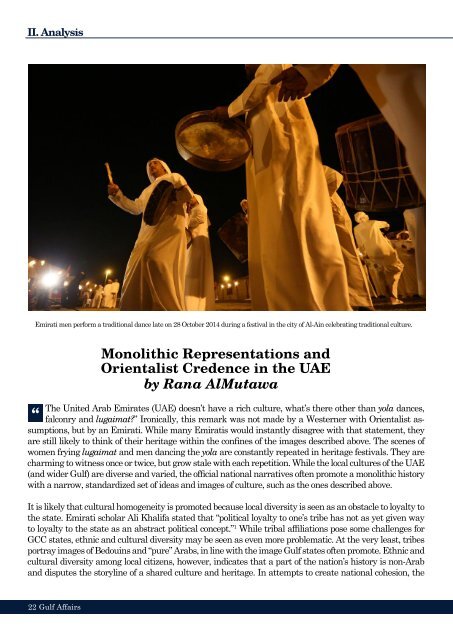You also want an ePaper? Increase the reach of your titles
YUMPU automatically turns print PDFs into web optimized ePapers that Google loves.
II. Analysis<br />
Emirati men perform a traditional dance late on 28 October 2014 during a festival in the city of Al-Ain celebrating traditional culture.<br />
Monolithic Representations and<br />
Orientalist Credence in the UAE<br />
by Rana AlMutawa<br />
The United Arab Emirates (UAE) doesn’t have a rich culture, what’s there other than yola dances,<br />
falconry and lugaimat?” Ironically, this remark was not made by a Westerner with Orientalist assumptions,<br />
but by an Emirati. While many Emiratis would instantly disagree with that statement, they<br />
are still likely to think of their heritage within the confines of the images described above. The scenes of<br />
women frying lugaimat and men dancing the yola are constantly repeated in heritage festivals. They are<br />
charming to witness once or twice, but grow stale with each repetition. While the local cultures of the UAE<br />
(and wider Gulf) are diverse and varied, the official national narratives often promote a monolithic history<br />
with a narrow, standardized set of ideas and images of culture, such as the ones described above.<br />
It is likely that cultural homogeneity is promoted because local diversity is seen as an obstacle to loyalty to<br />
the state. Emirati scholar Ali Khalifa stated that “political loyalty to one’s tribe has not as yet given way<br />
to loyalty to the state as an abstract political concept.” 1 While tribal affiliations pose some challenges for<br />
GCC states, ethnic and cultural diversity may be seen as even more problematic. At the very least, tribes<br />
portray images of Bedouins and “pure” Arabs, in line with the image Gulf states often promote. Ethnic and<br />
cultural diversity among local citizens, however, indicates that a part of the nation’s history is non-Arab<br />
and disputes the storyline of a shared culture and heritage. In attempts to create national cohesion, the<br />
22 Gulf Affairs


